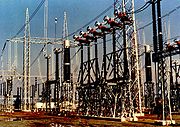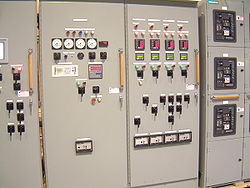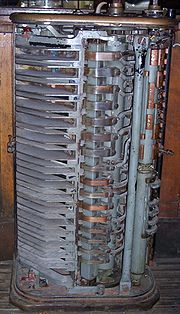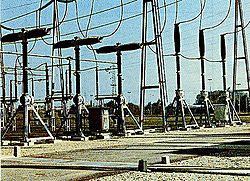
Switchgear
Encyclopedia




Electric power system
An electric power system is a network of electrical components used to supply, transmit and use electric power. An example of an electric power system is the network that supplies a region's homes and industry with power - for sizable regions, this power system is known as the grid and can be...
, or grid, refers to the combination of electrical disconnects, fuses
Fuse (electrical)
In electronics and electrical engineering, a fuse is a type of low resistance resistor that acts as a sacrificial device to provide overcurrent protection, of either the load or source circuit...
and/or circuit breaker
Circuit breaker
A circuit breaker is an automatically operated electrical switch designed to protect an electrical circuit from damage caused by overload or short circuit. Its basic function is to detect a fault condition and, by interrupting continuity, to immediately discontinue electrical flow...
s used to isolate electrical equipment. Switchgear is used both to de-energize equipment to allow work to be done and to clear faults
Fault (power engineering)
In an electric power system, a fault is any abnormal flow of electric current. For example, a short circuit is a fault in which current flow bypasses the normal load. An open-circuit fault occurs if a circuit is interrupted by some failure. In three-phase systems, a fault may involve one or more...
downstream. This type of equipment is important because it is directly linked to the reliability of the electricity
Electricity
Electricity is a general term encompassing a variety of phenomena resulting from the presence and flow of electric charge. These include many easily recognizable phenomena, such as lightning, static electricity, and the flow of electrical current in an electrical wire...
supply.
The very earliest central power stations used simple open knife switch
Knife switch
A knife switch is a type of switch used to control the flow of electricity in a circuit. It is composed of a hinge which allows a metal lever, or knife, to be lifted from or inserted into a slot or jaw. The hinge and jaw are both fixed to an insulated base, and the knife has an insulated handle to...
es, mounted on insulating panels of marble or asbestos. Power levels and voltages rapidly escalated, making open manually operated switches too dangerous to use for anything other than isolation of a de-energized circuit. Oil-filled equipment allowed arc energy to be contained and safely controlled. By the early 20th century, a switchgear line-up would be a metal-enclosed structure with electrically operated switching elements, using oil circuit breakers. Today, oil-filled equipment has largely been replaced by air-blast, vacuum, or SF6 equipment, allowing large currents and power levels to be safely controlled by automatic equipment incorporating digital controls, protection, metering and communications.
High voltage switchgear was invented at the end of the 19th century for operating motors
Electric motor
An electric motor converts electrical energy into mechanical energy.Most electric motors operate through the interaction of magnetic fields and current-carrying conductors to generate force...
and other electric machines. The technology has been improved over time and can be used with voltages up to 1,100 kV.
Typically switchgear in substations is located on both the high voltage and the low voltage side of large power transformer
Transformer
A transformer is a device that transfers electrical energy from one circuit to another through inductively coupled conductors—the transformer's coils. A varying current in the first or primary winding creates a varying magnetic flux in the transformer's core and thus a varying magnetic field...
s. The switchgear on the low voltage side of the transformers may be located in a building, with medium-voltage circuit breakers for distribution circuits, along with metering, control, and protection equipment. For industrial applications, a transformer
Transformer
A transformer is a device that transfers electrical energy from one circuit to another through inductively coupled conductors—the transformer's coils. A varying current in the first or primary winding creates a varying magnetic flux in the transformer's core and thus a varying magnetic field...
and switchgear line-up may be combined in one housing, called a unitized substation
Electrical substation
A substation is a part of an electrical generation, transmission, and distribution system. Substations transform voltage from high to low, or the reverse, or perform any of several other important functions...
or USS.
Housing
Switchgear for low voltages may be entirely enclosed within a building. For transmission levels of voltage (high voltages over 66 kV), often switchgear will be mounted outdoors and insulated by air, though this requires a large amount of space. Gas insulated switchgear used for transmission-level voltages saves space compared with air-insulated equipment, although it has a higher equipment cost. Oil insulated switchgear presents an oil spill hazard.At small substations, switches may be manually operated, but at important switching stations on the transmission network all devices have motor operators to allow for remote control.
Types
A piece of switchgear may be a simple open-air isolator switch or it may be insulated by some other substance. An effective although more costly form of switchgear is gas insulated switchgear (GIS), where the conductors and contacts are insulated by pressurized sulfur hexafluorideSulfur hexafluoride
Sulfur hexafluoride is an inorganic, colorless, odorless, and non-flammable greenhouse gas. has an octahedral geometry, consisting of six fluorine atoms attached to a central sulfur atom. It is a hypervalent molecule. Typical for a nonpolar gas, it is poorly soluble in water but soluble in...
gas
Gas
Gas is one of the three classical states of matter . Near absolute zero, a substance exists as a solid. As heat is added to this substance it melts into a liquid at its melting point , boils into a gas at its boiling point, and if heated high enough would enter a plasma state in which the electrons...
(SF6). Other common types are oil or vacuum insulated switchgear.
The combination of equipment within the switchgear enclosure allows them to interrupt fault currents of thousands of amps. A circuit breaker (within a switchgear enclosure) is the primary component that interrupts fault currents. The quenching of the arc when the circuit breaker pulls apart the contacts open (disconnects the circuit) requires careful design. Circuit breakers fall into these four types:
Oil
Oil circuit breakers rely upon vaporization of some of the oil to blast a jet of oil through the arc.Gas
Gas (SF6) circuit breakers sometimes stretch the arc using a magnetic field, and then rely upon the dielectric strength of the SF6 to quench the stretched arc.Vacuum
Vacuum circuit breakers have minimal arcing (as there is nothing to ionize other than the contact material), so the arc quenches when it is stretched a very small amount (<2–3 mm). At or near current zero the arc is not hot enough to maintain a plasma, and current ceases; the gap can then withstand the rise of voltage. Vacuum circuit breakers are frequently used in modern medium-voltage switchgear to 35,000 volts. Unlike the other types, they are inherently unsuitable for interrupting DC faults.Air
Air circuit breakers may use compressed air (puff) to blow out the arc, or alternatively, the contacts are rapidly swung into a small sealed chamber, the escaping of the displaced air thus blowing out the arc.Circuit breakers are usually able to terminate all current flow very quickly: typically between 30 ms and 150 ms depending upon the age and construction of the device.
Classification
Several different classifications of switchgear can be made:- By the current rating.
- By interrupting rating (maximum short circuitShort circuitA short circuit in an electrical circuit that allows a current to travel along an unintended path, often where essentially no electrical impedance is encountered....
current that the device can safely interrupt)- Circuit breakers can open and close on fault currents
- Load-break/Load-make switches can switch normal system load currents
- Isolators may only be operated while the circuit is dead, or the load current is very small.
- By voltage class:
- Low voltage (less than 1,000 volts AC)
- Medium voltage (1,000–35,000 volts AC)
- High voltage (more than 35,000 volts AC)
- By insulating medium:
- Air
- Gas (SF6 or mixtures)
- Oil
- Vacuum
- By construction type:
- Indoor (further classified by IP (Ingress Protection) class or NEMA enclosure type)
- Outdoor
- Industrial
- Utility
- Marine
- Draw-out elements (removable without many tools)
- Fixed elements (bolted fasteners)
- Live-front
- Dead-front
- Open
- Metal-enclosed
- Metal-clad
- Metal enclose & Metal clad
- Arc-resistant
- By IEC degree of internal separation
- No Separation (Form 1)
- Busbars separated from functional units (Form 2a, 2b, 3a, 3b, 4a, 4b)
- Terminals for external conductors separated from busbars (Form 2b, 3b, 4a, 4b)
- Terminals for external conductors separated from functional units but not from each other (Form 3a, 3b)
- Functional units separated from each other (Form 3a, 3b, 4a, 4b)
- Terminals for external conductors separated from each other (Form 4a, 4b)
- Terminals for external conductors separate from their associated functional unit (Form 4b)
- By interrupting device:
- Fuses
- Air Blast Circuit Breaker
- Minimum Oil Circuit Breaker
- Oil Circuit Breaker
- Vacuum Circuit Breaker
- Gas (SF6) Circuit breakerSulfur hexafluoride circuit breakerHigh-voltage circuit-breakers have greatly changed since they were first introduced in the mid-1950s, and several interrupting principles have been developed that have contributed successively to a large reduction of the operating energy...
- By operating method:
- Manually operated
- Motor-operated
- Solenoid/stored energy operated
- By type of current:
- Alternating current
- Direct current
- By application:
- Transmission system
- Distribution
- By purpose
- Isolating switches (disconnectors)
- Load-break switches.
- Grounding (earthing) switches
A single line-up may incorporate several different types of devices, for example, air-insulated bus, vacuum circuit breakers, and manually operated switches may all exist in the same row of cubicles.
Ratings, design, specifications and details of switchgear are set by a multitude of standards. In North America mostly IEEE and ANSI
Ansi
Ansi is a village in Kaarma Parish, Saare County, on the island of Saaremaa, Estonia....
standards are used, much of the rest of the world uses IEC
International Electrotechnical Commission
The International Electrotechnical Commission is a non-profit, non-governmental international standards organization that prepares and publishes International Standards for all electrical, electronic and related technologies – collectively known as "electrotechnology"...
standards, sometimes with local national derivatives or variations.
Functions
One of the basic functions of switchgear is protection, which is interruption of short-circuit and overload fault currents while maintaining service to unaffected circuits. Switchgear also provides isolation of circuits from power supplies. Switchgear is also used to enhance system availability by allowing more than one source to feed a load.Safety
To help ensure safe operation sequences of switchgear, trapped key interlockingTrapped key interlocking
Trapped key interlocking utilizes locks and keys for sequential control of equipment and machinery to ensure safe operation. A simple system might consist of two locks and a single key. Normally inserting the key into a lock would enable a power supply, thus in this simple system only one power...
provides predefined scenarios of operation. For example, if only one of two sources of supply are permitted to be connected at a given time, the interlock scheme may require that the first switch must be opened to release a key that will allow closing the second switch. Complex schemes are possible.
Indoor switchgear can also be type tested for internal arc containment (e.g. IEC 62271-200). This test is important for user safety as modern switchgear is capable of switching large currents. (https://www.energy.siemens.com/cms/00000013/aune/Documents/Medium%20Voltage%20Arc%20Fault%20Containment.pdf)
Switchgear is often inspected using thermal imaging to assess the state of the system and predict failures before they occur. Other methods include partial discharge (PD) testing, using either fixed or portable testers, and acoustic emission testing using surface-mounted transducers (for oil equipment) or ultrasonic detectors used in outdoor switchyards. SF6 equipment is invariably fitted with alarms and interlocks to warn of loss of pressure, and to prevent operation if the pressure falls too low.
The increasing awareness of dangers associated with high fault levels has resulted in network operators specifying closed door operation for operating earth switches and racking breakers. Many European power companies have banned operators from switch rooms while operating. Remote racking system
Remote racking system
A remote racking system is a system that allows an operator to operate a racking system from a remote location. It offers a safe alternative to manually racking circuit breakers, which reduces the requirement for service personnel to wear a full-body arc flash hazard suit for...
s are available which allow an operator to rack switchgear from a remote location without the need to wear a protective arc flash hazard suit.
 |
 |
| 245 kV circuit breaker in air insulated substation | 420 kV gas insulated switchgear |
External links
IEC TC17: Switchgear & ControlgearTechnical Committee, on tc17.iec.ch IEEE Switchgear Committee, on ewh.ieee.org Course ETHZ, handouts_2.pdf, on eeh.ee.ethz.ch
- http://www.PowerSystemSpecialists.com
- http://www.SafetyRacking.com

